“Analog LED strips offer straightforward, uniform lighting, making them ideal for simple decorative and ambient applications. Digital LED strips provide individual LED control, enabling dynamic, customizable lighting effects suited for detailed or specialized installations. Clearly understanding these differences helps you select the ideal LED strip for your project.”
Understanding Analog and Digital LED Strips
Having personally worked extensively with both analog and digital LED strips, I’d like to clearly explain their fundamental differences and functionalities, making it easier for you to decide which type best fits your project.
What is an Analog LED Strip?
Analog LED strips (often called “non-addressable” or “dumb” LED strips) provide uniform lighting across the entire strip. From my practical experience, they offer simple control and straightforward installation. Typically, they are controlled as one entire unit, meaning the whole strip displays the same color and brightness simultaneously.
What is a Digital LED Strip?
Digital LED strips (also known as “addressable” LED strips) provide control at the individual LED level. This means each LED can display a different color and brightness independently. In my experience, digital LED strips enable dynamic, intricate lighting effects and customizable displays, ideal for specialized or creative lighting setups.
A common question people ask me is, “What’s the main difference between analog and digital LED strips?” The primary difference is control—analog LED strips can only display one color at a time for the entire strip, while digital LED strips allow individual LED customization, enabling complex and dynamic lighting effects.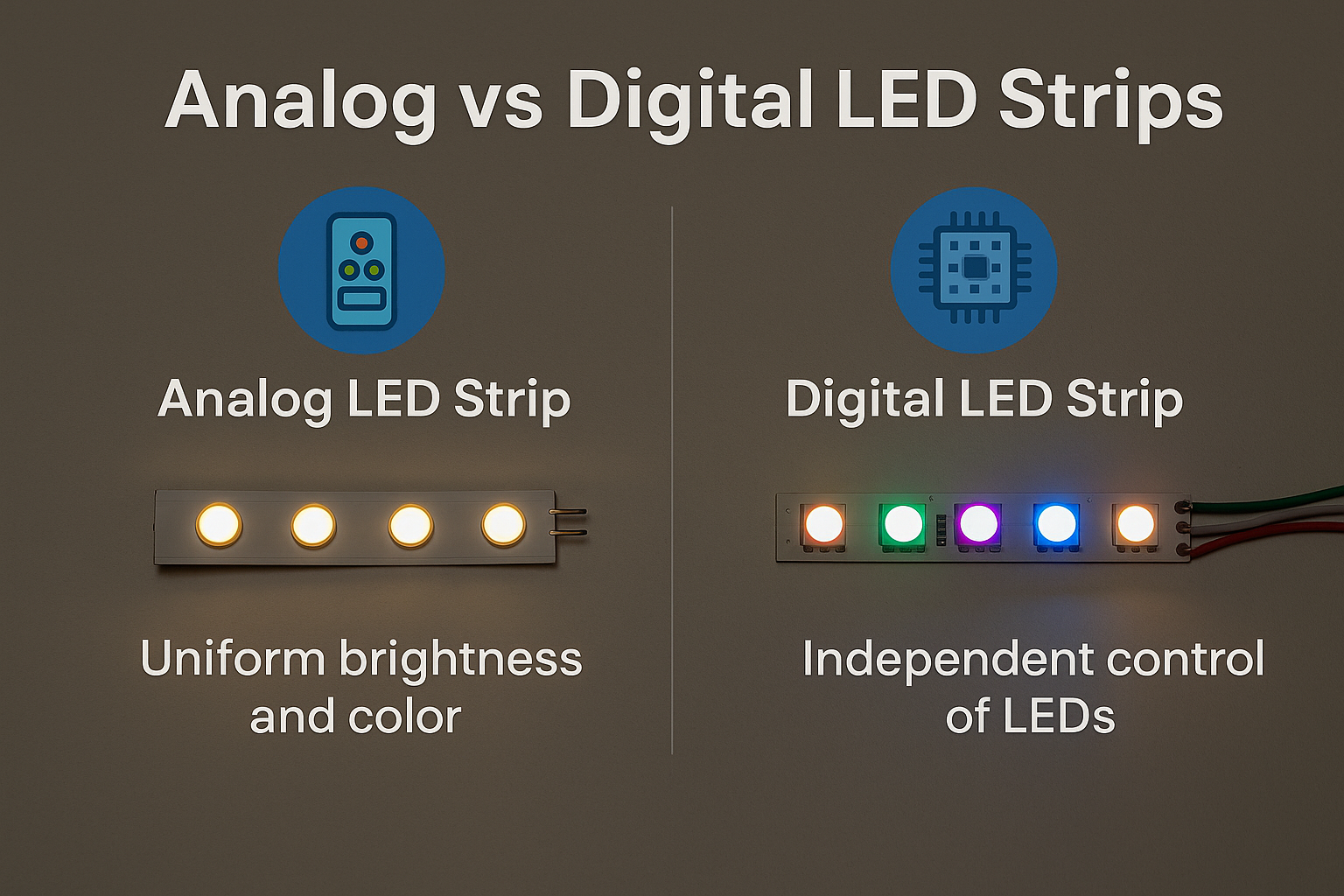
Technical Differences Clearly Explained
Drawing from my practical experience with LED lighting installations, I’ll clearly outline the technical distinctions between analog and digital LED strips, making it straightforward for you to understand and decide which suits your project best.
Lighting Control & Functionality
- Analog LED Strips:
These strips provide uniform brightness and color across their entire length. They’re controlled via simple RGB controllers, with the entire strip changing simultaneously.
- Digital LED Strips:
Allow independent control of each individual LED or group of LEDs. This means you can create complex lighting effects, animations, and detailed designs, ideal for dynamic applications.
Brightness & Color Capabilities
- Analog LED Strips:
Typically provide uniform and stable brightness, making them suitable for basic lighting applications. However, they lack the ability to display multiple colors simultaneously across different parts of the strip.
- Digital LED Strips:
Offer dynamic, variable brightness and multi-color capabilities, clearly suitable for creative and intricate lighting scenarios.
Installation Complexity
- Analog LED Strips:
Generally easier to install, requiring simpler wiring and basic RGB controllers, making them well-suited for DIY or simple installations.
- Digital LED Strips:
Installation can be more complex due to the need for specific controllers, data signals, and additional wiring considerations.
Many clients often ask me, “Are RGB LED strips analog or digital?” Clearly, RGB LED strips can be either. Analog RGB strips display one color at a time along their entire length, whereas digital RGB strips allow each LED to be individually controlled, enabling multi-color, dynamic effects.
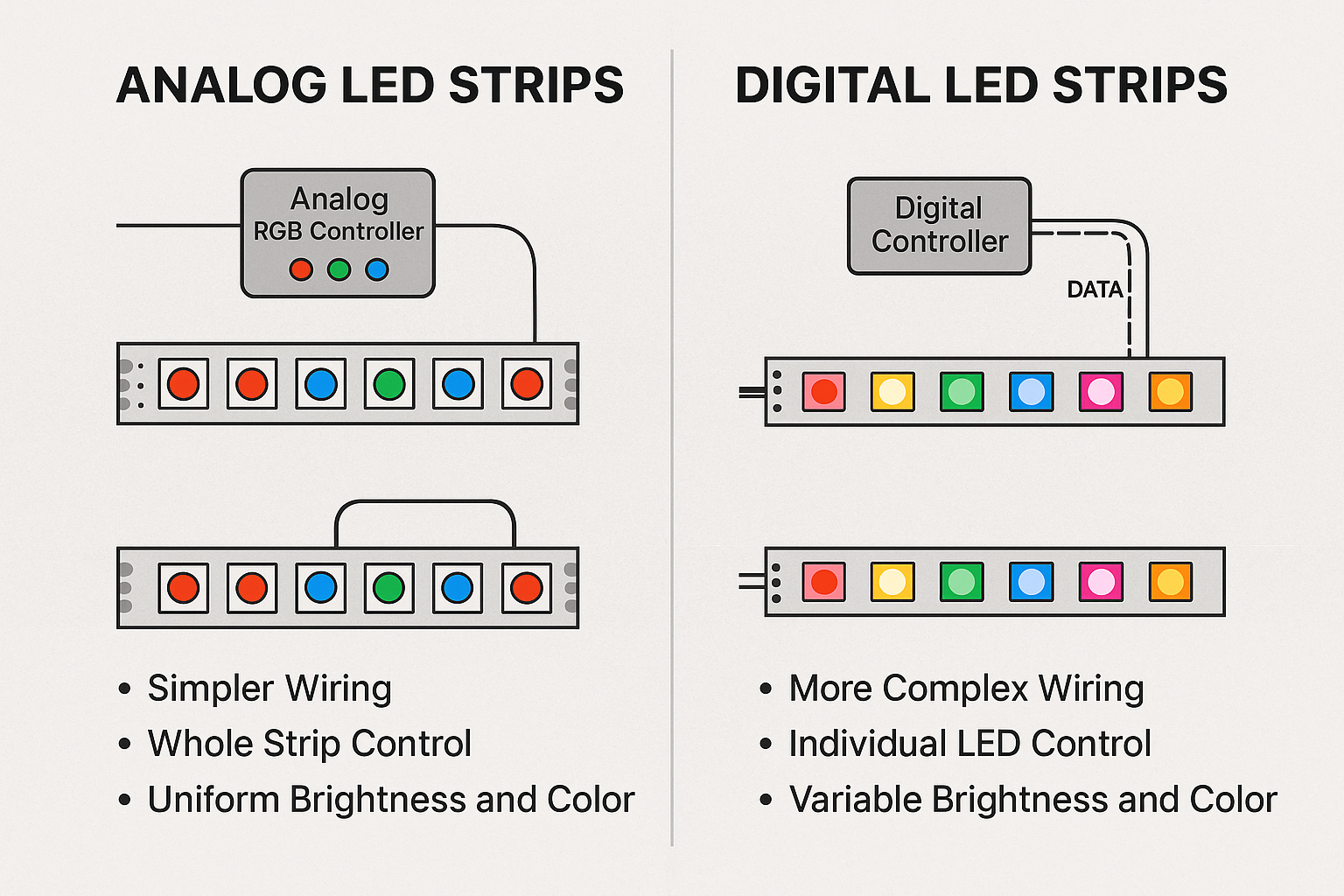
Advantages and Disadvantages of Analog LED Strips
Drawing from my personal experience installing analog LED strips in various scenarios, I’ll clearly outline their strengths and limitations to help you decide if they’re suitable for your lighting project.
Advantages of Analog LED Strips
- Ease of Installation:
Analog LED strips are simple to install, requiring only straightforward wiring and basic RGB controllers. This makes them ideal for DIY projects and residential setups.
- Cost-Effective:
Typically more affordable than digital LED strips, clearly beneficial for budget-conscious lighting projects.
- Reliable Performance:
With fewer components and simpler controls, analog strips usually offer reliable, consistent lighting performance over time.
Disadvantages of Analog LED Strips
- Limited Control:
Analog strips cannot individually control LEDs, meaning the entire strip changes color uniformly without dynamic effects or customized animations.
- Less Versatile:
Limited in creating intricate or complex lighting scenarios, restricting creativity and design options.
Clients frequently ask me, “Can analog LED strips handle dynamic lighting effects?” Clearly, analog strips cannot achieve dynamic, multi-color effects across individual segments—this functionality requires digital LED strips.
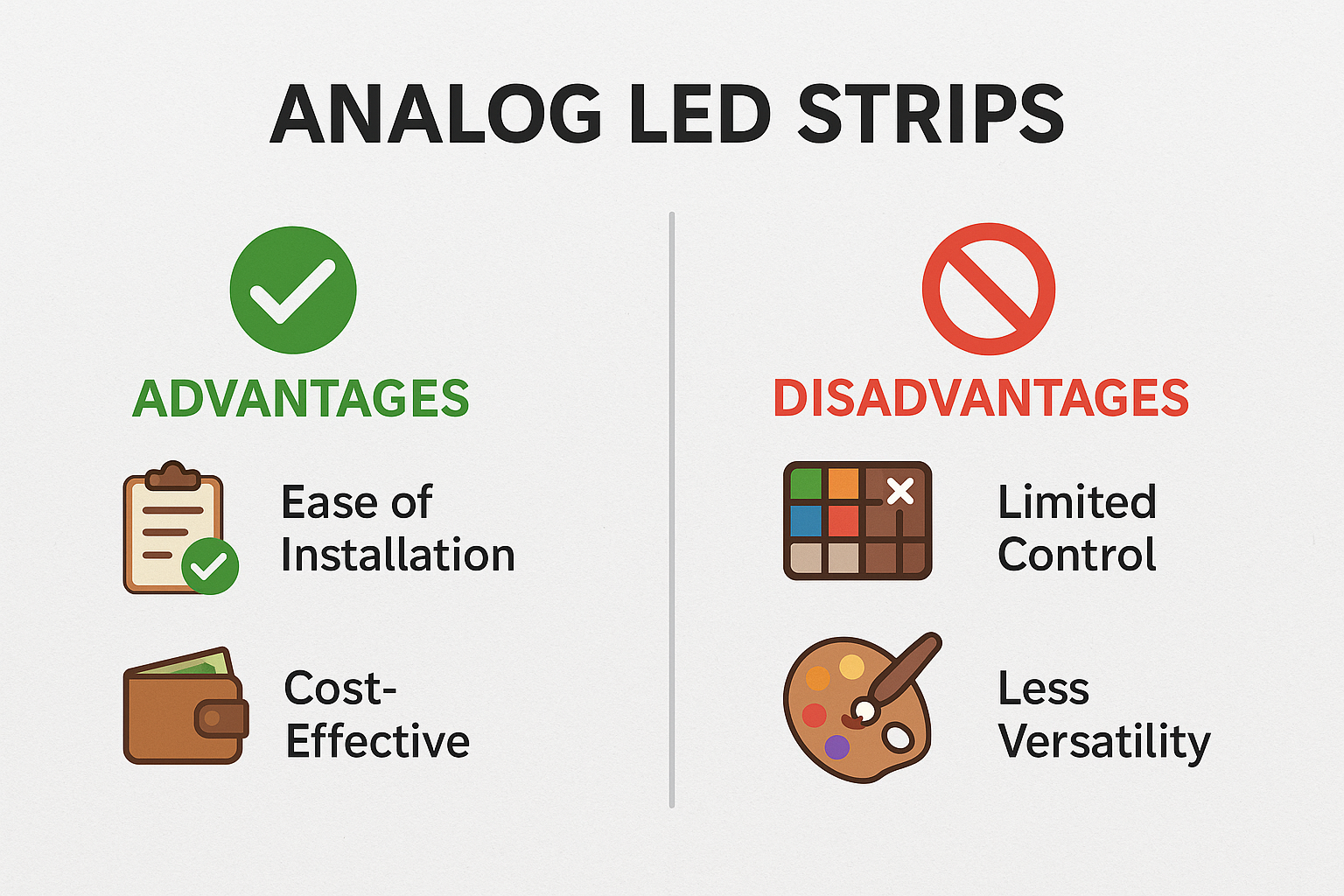
Advantages and Disadvantages of Digital LED Strips
From my experience installing digital LED strips, I’ve learned firsthand about their unique strengths and considerations. Here, I’ll clearly outline their advantages and potential drawbacks to help you decide if they’re right for your lighting project.
Advantages of Digital LED Strips
- Individual LED Control:
Digital strips allow independent control of each LED, enabling you to create complex animations, dynamic patterns, and customizable effects clearly ideal for specialized or creative lighting setups.
- Dynamic Lighting Effects:
Ideal for scenarios requiring vibrant, varied lighting effects—perfect for events, stage lighting, entertainment spaces, and advanced residential applications.
- Versatility:
Offers extensive customization possibilities, clearly making digital LED strips ideal for detailed installations and creative projects.
Disadvantages of Digital LED Strips
- Higher Cost:
Typically more expensive upfront than analog strips due to advanced control features and individual LED addressing capabilities.
- Complex Installation:
Requires specialized controllers and additional wiring, making installation more complex and potentially requiring professional assistance.
- Power and Data Management:
Clearly necessitates careful planning for adequate power supply, data signal management, and heat dissipation, especially for extensive installations.
Clients often ask me, “Are digital LED strips worth the extra complexity and cost?” Clearly, if your project demands dynamic lighting effects, customization, and detailed visual impact, digital LED strips justify the extra investment and installation complexity.
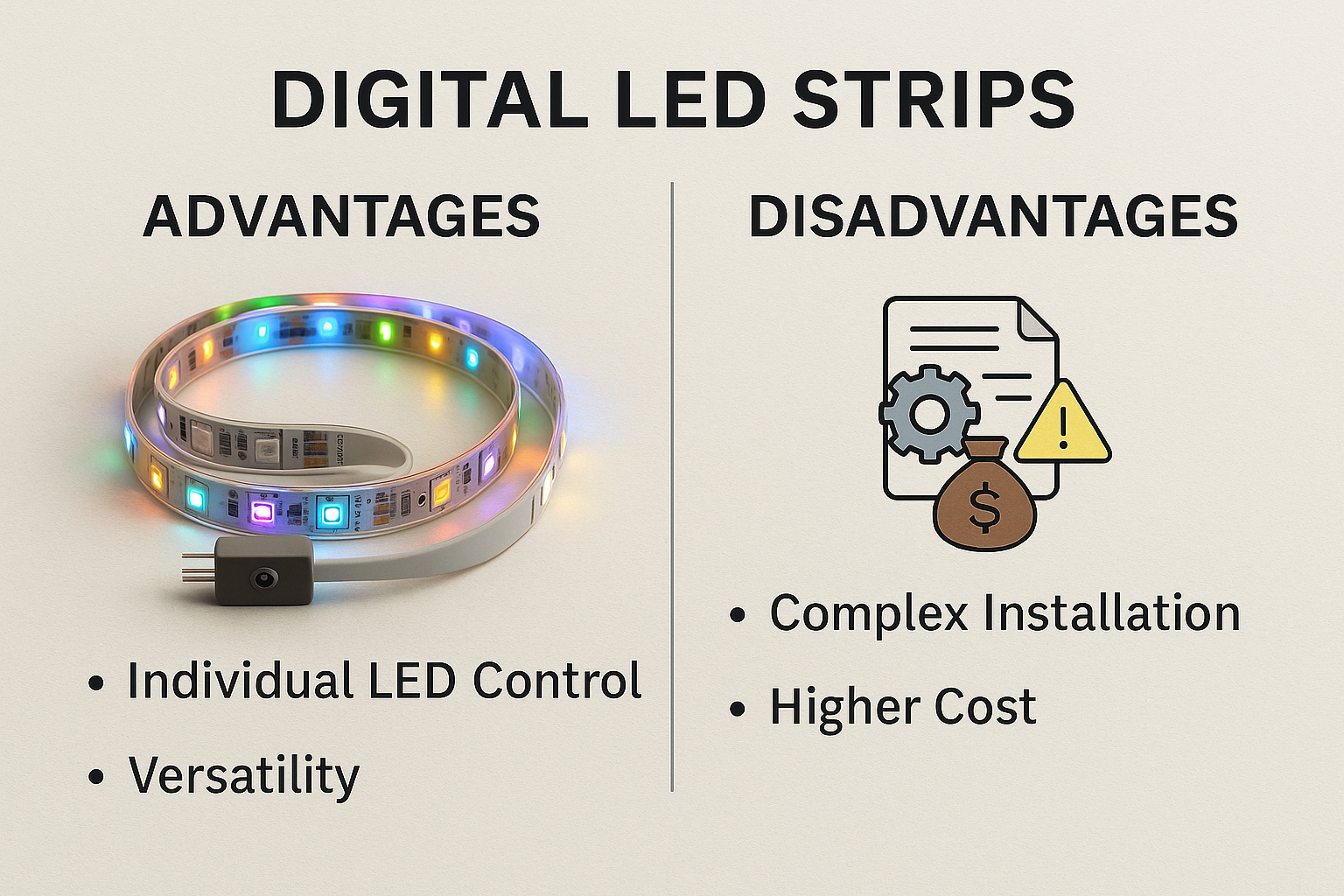
Best Applications & Practical Scenarios
Having personally installed both analog and digital LED strips across various settings, I can clearly guide you toward choosing the most suitable type for your project. Here are clear practical examples and scenarios for each type.
Ideal Uses for Analog LED Strips
Analog LED strips are particularly suited for straightforward applications, including:
- Residential Ambient Lighting:
Clearly ideal for living rooms, bedrooms, and general home lighting setups requiring uniform illumination.
- Decorative Lighting:
Excellent for accent lighting around furniture, shelving, or architectural features where consistent and subtle lighting is desired.
- Budget-Friendly Installations:
Clearly beneficial for cost-conscious projects due to their affordability and simple installation process.
Ideal Uses for Digital LED Strips
Digital LED strips excel in specialized applications that demand dynamic lighting effects:
- Event and Stage Lighting:
Perfect for events, performances, and stages where individual LED control enables dynamic and dramatic visual effects.
- Entertainment Spaces:
Clearly ideal for home theaters, gaming setups, bars, and clubs, enhancing visual ambiance with customizable lighting patterns.
- Advanced Decorative Applications:
Ideal for architectural lighting or detailed interior designs where unique, complex visual effects are clearly desirable.
People often ask me, “Should I choose digital or analog LED strips for my home?” If you’re aiming for simple, uniform lighting on a budget, analog strips are clearly sufficient. However, for dynamic, customizable lighting effects and intricate designs, digital LED strips are clearly superior.
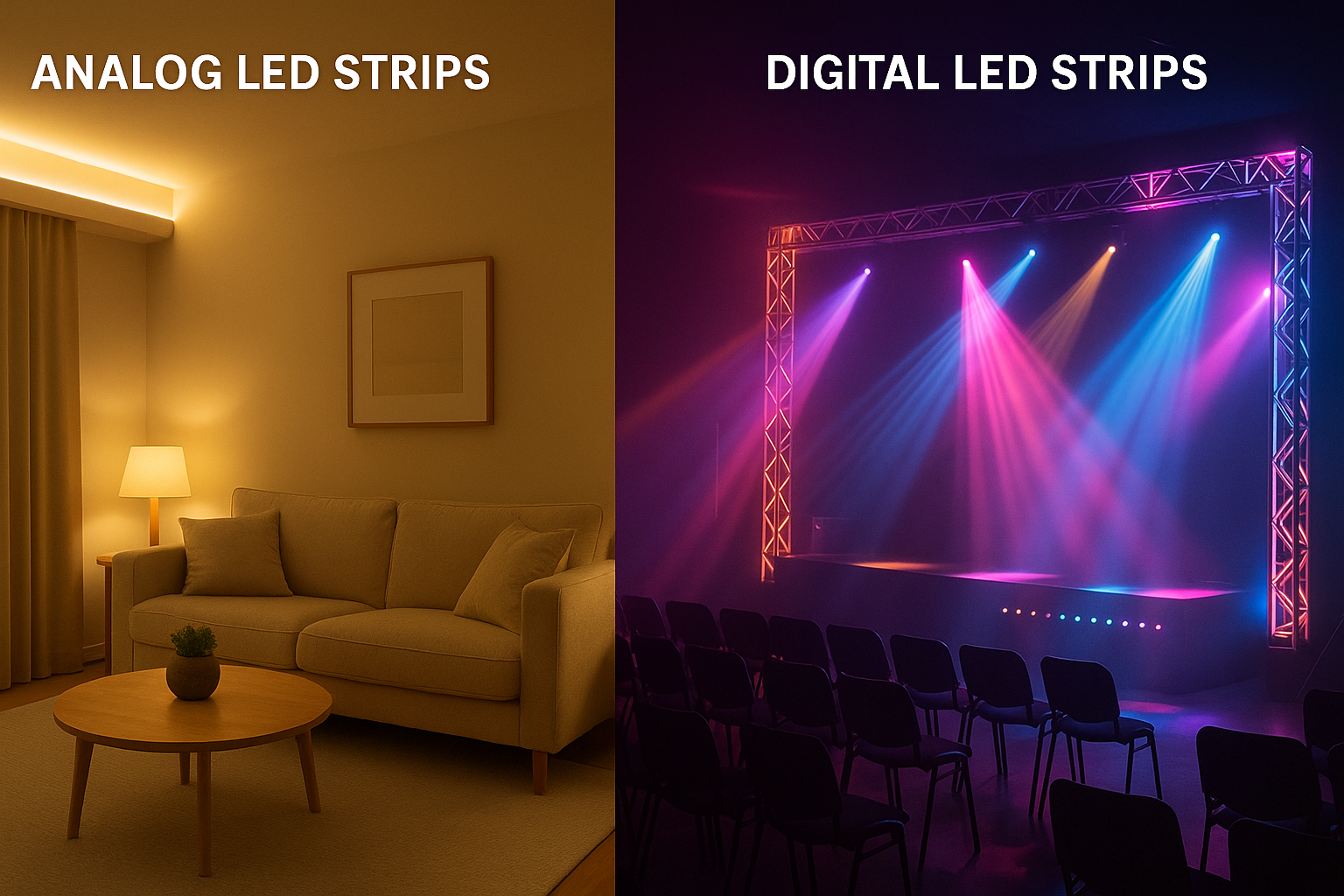
How to Choose Between Analog and Digital LED Strips
From my practical experience installing both analog and digital LED strips, I clearly understand the key considerations when selecting between them. Here’s a straightforward guide to help you choose confidently, avoiding common pitfalls along the way.
Key Decision Factors
- Lighting Effects Needed:
Clearly consider whether your project requires dynamic, individual LED control (digital) or simple, uniform illumination (analog).
- Installation Complexity:
For easier, straightforward installations, analog LED strips are ideal. If you are prepared to handle additional wiring and controllers for dynamic effects, digital strips clearly offer more capabilities.
- Budget and Cost Considerations:
Clearly define your budget—analog strips are generally more affordable and cost-effective, while digital strips offer advanced capabilities at a higher initial cost.
- Application Environment:
Evaluate your project environment clearly—digital strips excel in specialized or creative setups, while analog strips suit general decorative and ambient lighting.
Common Mistakes and Practical Recommendations
- Misjudging Lighting Needs:
A common mistake I’ve observed is selecting analog LED strips for projects clearly requiring dynamic effects, or choosing digital strips unnecessarily for basic ambient lighting.
- Underestimating Installation Requirements:
Digital LED strips require additional planning for controllers, data management, and power supplies. Clearly anticipate these needs upfront to avoid issues.
- Choosing Based Solely on Cost:
Clearly evaluate long-term functionality, installation ease, and lighting effect needs instead of simply focusing on upfront costs.
Clients often ask me, “When should I invest in digital LED strips over analog?” Clearly, digital LED strips are worth the investment if your project demands individual LED control, complex visual effects, or detailed customization. For simpler installations with uniform lighting, analog strips are sufficient and cost-effective.
External Link:
Analog vs Digital LED strip – QuinLED
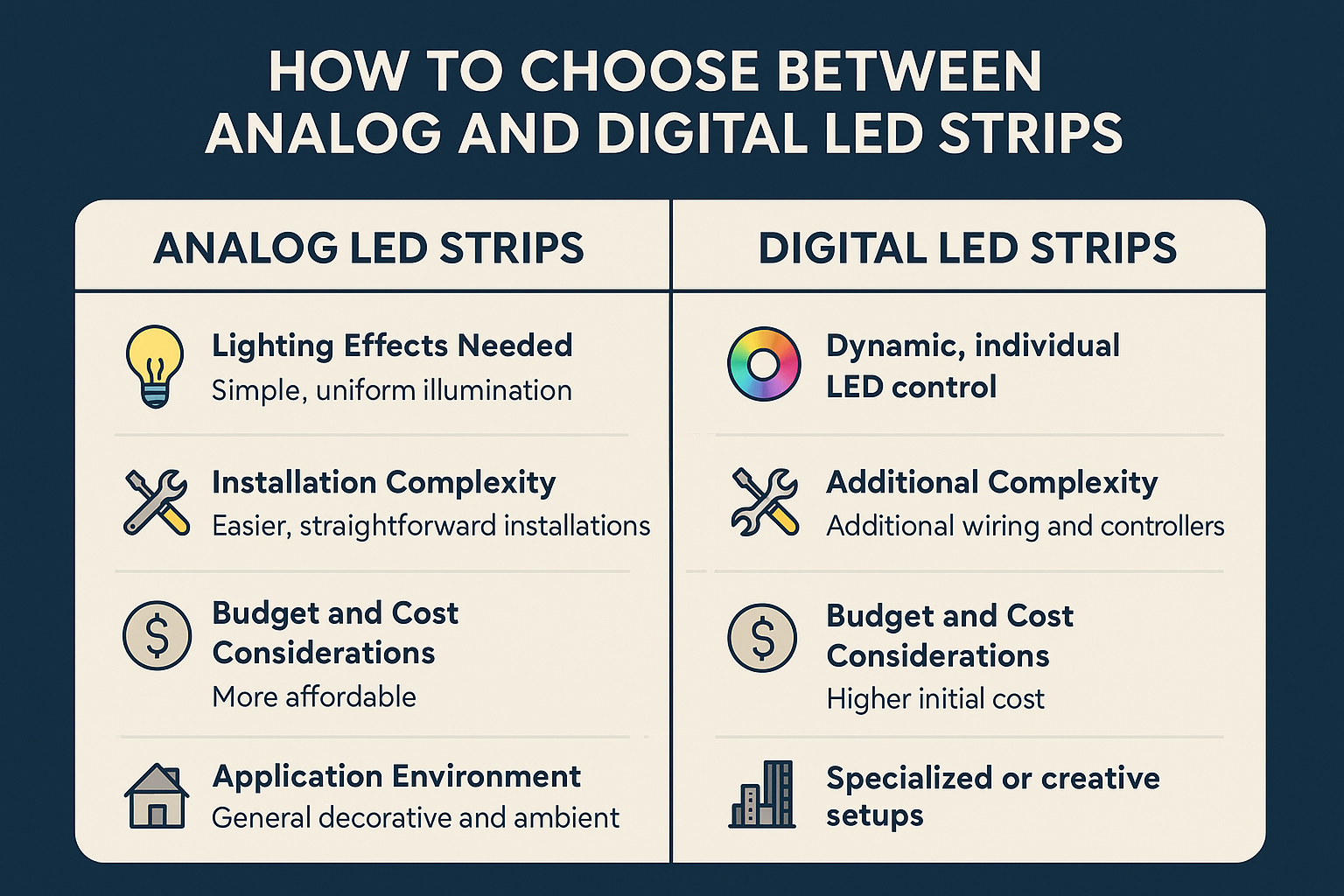
Installation, Maintenance & Expert Recommendations
Having installed numerous analog and digital LED strips, I’ve learned firsthand the key considerations and practical steps to ensure optimal performance. Here is clear guidance to help you through installation, maintenance, and troubleshooting.
Step-by-Step Installation Guide
Analog LED Strips Installation:
- Plan Your Layout Clearly:
Identify precise locations, measure accurately, and plan wiring routes carefully.
- Surface Preparation:
Ensure surfaces are clean and smooth for secure adhesion.
- Easy Installation:
Attach the strips firmly using adhesive backing or clips, clearly connecting to compatible analog RGB controllers.
- Final Checks and Testing:
Verify connections, power supply, and brightness uniformity clearly before finalizing installation.
Digital LED Strips Installation:
- Detailed Planning:
Clearly plan placement, power supply, data lines, and controller positioning due to more complex requirements.
- Secure Mounting & Wiring:
Attach digital strips securely, clearly considering additional wiring for data signals and individual LED control.
- Proper Controller Setup:
Clearly connect the digital strips to compatible controllers, ensuring correct data and power connections.
- Comprehensive Testing:
Test each segment clearly and individually to ensure proper operation, color accuracy, and consistency.
Essential Maintenance Practices
- Routine Inspections:
Periodically check connections, power supply reliability, brightness consistency, and functionality.
- Heat Management:
Clearly provide adequate heat dissipation, particularly for digital strips with higher density or extended lengths.
- Regular Cleaning:
Keep LED strips clean using a soft cloth to maintain brightness, visual clarity, and overall performance.
Troubleshooting Common Issues
- Brightness Issues:
Verify adequate power supply, clear connections, and proper compatibility with controllers.
- Data Signal Problems (Digital LED strips):
Clearly inspect and manage data wiring and connections carefully to prevent signal loss or erratic lighting behavior.
- Overheating:
Implement clear heat dissipation methods (e.g., aluminum channels) to manage heat, particularly for digital LED strips.
Clients frequently ask me, “What issues commonly arise during LED strip installations?” Clearly, the most common problems include improper power supply, inadequate heat management, incorrect controller compatibility, and insufficient planning of wiring routes.
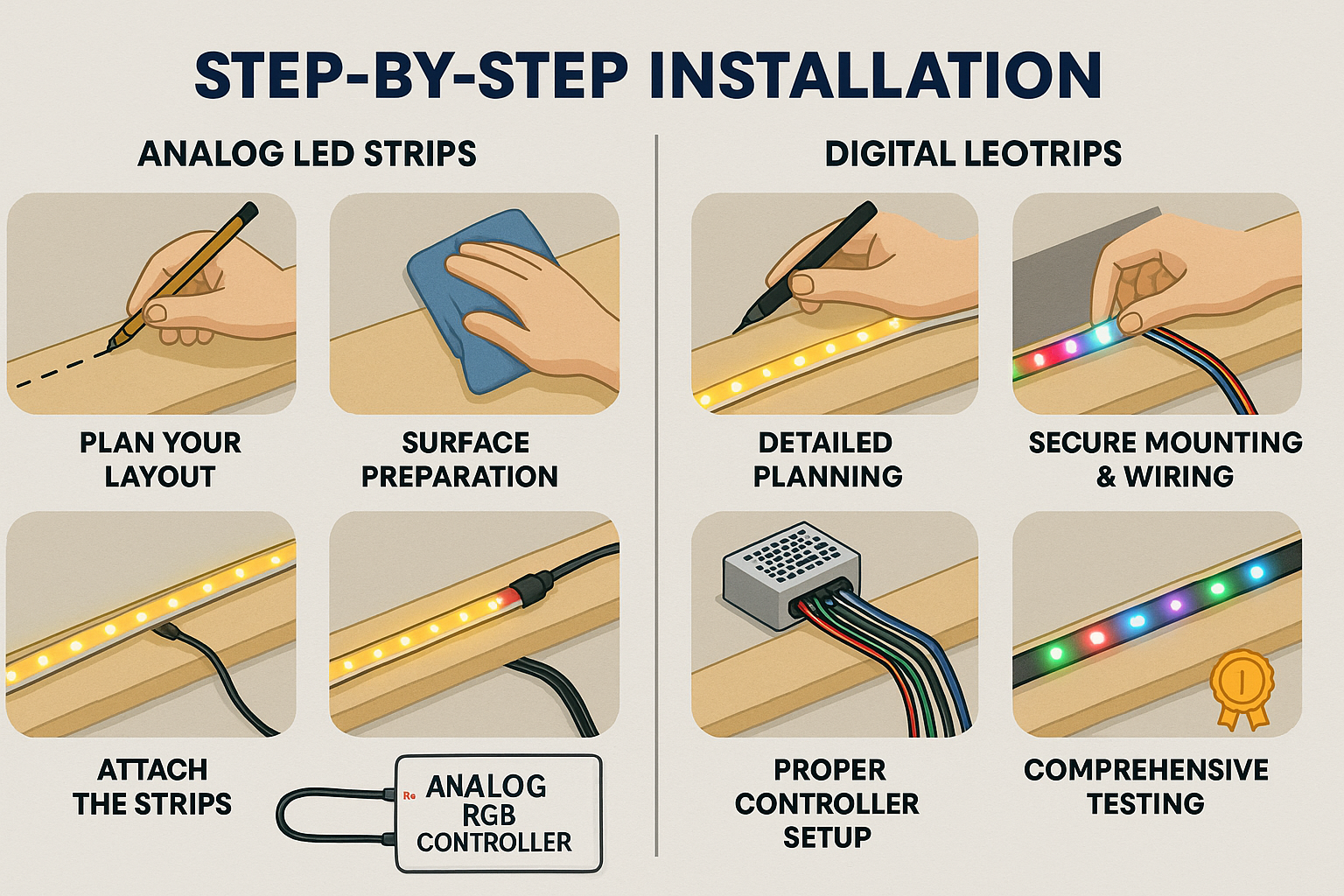
FAQs About Analog and Digital LED Strips
Based on my personal experience working extensively with both analog and digital LED strips, here are clear answers to some of the most common questions I often receive.
What is the main difference between analog and digital LED strips?
The primary difference clearly lies in control capabilities. Analog LED strips change color and brightness uniformly across the entire strip, whereas digital LED strips allow individual LED control, enabling detailed, dynamic lighting effects and animations.
Are RGB LED strips analog or digital?
RGB LED strips can be either analog or digital. Analog RGB strips display one uniform color at a time across the entire length, while digital RGB (addressable RGB) strips allow individual LED customization and multiple colors simultaneously.
Can digital LED strips be used for basic ambient lighting?
Yes, digital LED strips can clearly be used for ambient lighting. However, their true advantage lies in customizable lighting effects. For simple, uniform ambient lighting, analog strips might offer a more straightforward and cost-effective solution.
Conclusion & Next Steps
Clearly understanding the key differences between analog and digital LED strips is essential for achieving the best results in your lighting project. Analog LED strips are ideal for straightforward, budget-friendly installations requiring uniform lighting. Digital LED strips excel in applications demanding intricate, customizable, and dynamic lighting effects, suitable for creative and detailed lighting designs.
Drawing from my practical experience, I encourage you to clearly evaluate your specific requirements—such as brightness, customization, installation complexity, and budget—before choosing the ideal LED strip type.
Ready to select the perfect LED strip for your lighting project?
Explore Elstar’s LED Lighting Solutions →








